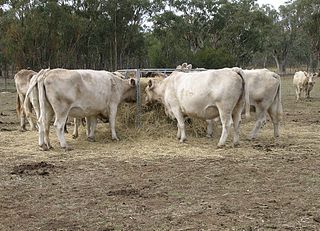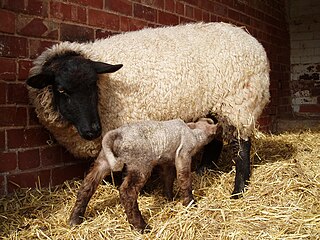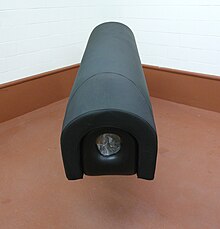
Horse breeding is reproduction in horses, and particularly the human-directed process of selective breeding of animals, particularly purebred horses of a given breed. Planned matings can be used to produce specifically desired characteristics in domesticated horses. Furthermore, modern breeding management and technologies can increase the rate of conception, a healthy pregnancy, and successful foaling.

Artificial insemination is the deliberate introduction of sperm into a female's cervix or uterine cavity for the purpose of achieving a pregnancy through in vivo fertilization by means other than sexual intercourse. It is a fertility treatment for humans, and is common practice in animal breeding, including dairy cattle and pigs.

A broiler is any chicken that is bred and raised specifically for meat production. Most commercial broilers reach slaughter weight between four and six weeks of age, although slower growing breeds reach slaughter weight at approximately 14 weeks of age. Typical broilers have white feathers and yellowish skin. Broiler or sometimes broiler-fryer is also used sometimes to refer specifically to younger chickens under 2.0 kilograms, as compared with the larger roasters.
Insemination is the introduction of sperm into a female’s reproductive system for the purpose of impregnating, also called fertilizing, the female for sexual reproduction. The sperm is introduced into the uterus of a mammal or the oviduct of an oviparous (egg-laying) animal. In mammals, insemination normally occurs during sexual intercourse or copulation, but insemination can take place in other ways, such as by artificial insemination.
Electroejaculation is a procedure used to obtain semen samples from sexually mature male mammals. The procedure is used for breeding programs and research purposes in various species, as well as in the treatment of ejaculatory dysfunction in human males. This procedure is used frequently with large mammals, particularly bulls and some domestic animals, as well as humans who have certain types of anejaculation. Electroejaculation has also been used for the cryoconservation of animal genetic resources, where semen is stored in low temperatures with the intent of conserving genetic material and future revival.

Semen collection refers to the process of obtaining semen from human males or other animals with the use of various methods, for the purposes of artificial insemination, or medical study. Semen can be collected via masturbation, prostate massage, artificial vagina, penile vibratory stimulation (vibroejaculation) and electroejaculation. Semen can be collected from endangered species for cryopreservation of genetic resources.
Theriogenology is a specialty of veterinary medicine concerned with animal reproduction. This includes the physiology and pathology of male and female reproductive systems of animals and the clinical practice of veterinary obstetrics, gynecology, andrology and assisted reproductive technologies (ART). Theriogenologists are veterinarians with advanced training in animal reproduction like semen analysis, evaluation and processing, breeding soundness, IVF, embryo transfer and obstetrics. In the United States, all theriogenologists are board-certified by the American College of Theriogenologists.

Captive breeding, also known as captive propagation, is the process of maintaining plants or animals in controlled environments, such as wildlife reserves, zoos, botanic gardens, and other conservation facilities. It is sometimes employed to help species that are being threatened by the effects of human activities such as climate change, habitat loss, fragmentation, over hunting or fishing, pollution, predation, disease, and parasitism.

A stud animal is a registered animal retained for breeding. The terms for the male of a given animal species usually imply that the animal is intact—that is, not castrated—and therefore capable of siring offspring. A specialized vocabulary exists for de-sexed animals and those animals used in grading up to a purebred status.

The Bali cattle, also known as Balinese cattle, domestic banteng or Bali banteng, are a domesticated species of bovine which originated from the banteng. Bali cattle are an important source of meat and are used for plowing. They are thought to have originated in Bali.

A stud farm or stud in animal husbandry is an establishment for selective breeding of livestock. The word "stud" comes from the Old English stod meaning "herd of horses, place where horses are kept for breeding". Historically, documentation of the breedings that occur on a stud farm leads to the development of a stud book. Male animals made available for breeding to outside female animals are said to be "standing at stud", or at "stud service", referencing the relatively high probability that they are kept at a stud farm.
Canine reproduction is the process of sexual reproduction in domestic dogs, wolves, coyotes and other canine species.

Frozen bovine semen is a method of preserving bovine semen for future artificial insemination, even after the death of the donor.

The Australian Charbray is an Australian breed of cattle derived from a cross between the French Charolais cattle and American Brahman cattle. The charbray breed was first conceived in the United States of America in the 1930s and later introduced into Australia in 1969. In Australia, Australian charbray breeders are concentrated in the tropical Northern regions of Queensland. As of 1977, the official breeder society of Charbray cattle in Australia and New Zealand is the Charbray Society of Australia Limited, responsible for recording Charbray cattle in herd books, fostering improvement, enhancement and sales of Charbray cattle.

The human penis is an external male intromittent organ that additionally serves as the urinary duct. The main parts are the root (radix); the body (corpus); and the epithelium of the penis including the shaft skin and the foreskin (prepuce) covering the glans penis. The body of the penis is made up of three columns of tissue: two corpora cavernosa on the dorsal side and corpus spongiosum between them on the ventral side. The human male urethra passes through the prostate gland, where it is joined by the ejaculatory duct, and then through the penis. The urethra traverses the corpus spongiosum, and its opening, the meatus, lies on the tip of the glans penis. It is a passage both for urination and ejaculation of semen

Domestic sheep reproduce sexually much like other mammals, and their reproductive strategy is furthermore very similar to other domestic herd animals. A flock of sheep is generally mated by a single ram, which has either been chosen by a farmer or has established dominance through physical contest with other rams. Most sheep have a breeding season (tupping) in the autumn, though some are able to breed year-round.

An artificial vagina is a device designed to imitate the female sex organ. To achieve this, it will generally be made of a soft material, lubricated, and sometimes heated.

Non-reproductive sexual behavior consists of sexual activities animals participate in that do not lead to the reproduction of the species. Although procreation continues to be the primary explanation for sexual behavior in animals, recent observations on animal behavior have given alternative reasons for the engagement in sexual activities by animals. Animals have been observed to engage in sex for social interaction bonding, exchange for significant materials, affection, mentorship pairings, sexual enjoyment, or as demonstration of social rank. Observed non-procreative sexual activities include non-copulatory mounting, oral sex, genital stimulation, anal stimulation, interspecies mating, and acts of affection, although it is doubted that they have done this since the beginning of their existence. There have also been observations of sex with cub participants, same-sex sexual interaction, as well as sex with dead animals.
The Animal Reproduction Research Institute (ARRI) may be considered to date back to 1968 when the first center for bull investigation in Egypt was established. Its main responsibilities were the examination of bulls used for artificial insemination or natural breeding purposes, in addition to examining samples received from districts throughout Egypt for diagnostic purposes. long before that time, however, different aspects of animal reproduction were practiced in an informal, and later, formal manner. for example, artificial insemination has been applied in a primitive fashion for hundreds of years. Fresh semen, collected from newly impregnated female animals, was injected into other female animals.

Cryoconservation of animal genetic resources is a strategy wherein samples of animal genetic materials are preserved cryogenically.















